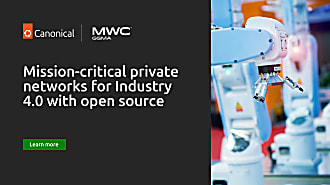Maarten Ectors
on 11 March 2017
The cheapest and smartest mobile and IoT base station of MWC17
How to solve the top telecom industry problems (declining revenues, spiralling costs, slow time to market) and revolutionise the wireless industry? Open Source Mobile and IoT Base Stations with App Stores.
At MWC15 we presented the smartest top of the rack switch of the show. Many network experts did not believe that the cheapest server with 6 Ethernet ports on Amazon.com and no network acceleration could be the smartest switch. After seeing that a switch which is defined via an app store and network apps, could also be a firewall, a load balancer, have IoT platforms run on it and control a robotic arm, they had to admit software is defining every thing. At MWC16 we had a lot smarter switches from the Broadcom ecosystem and on MWC17 we presented the first Open Source Switch with App Store, designed by Facebook.



The Cheapest Base Station of MWC17?
How can a software defined radio company like Lime Micro and an open source operating system company like Canonical, claim they have the cheapest mobile and IoT base station of MWC 2017? The reason is that this is the first open source base station with an app store. The hardware is just regular Intel servers and the only addition is a professional PCI version of the same LimeSDR, professional amplifiers and antennas. Since most of these elements are now commodity and the design for the LimeSDR is open source, any mass hardware producer can now copy the design and drive down the price. With higher volumes come lower prices. Even Amazon.com can help deliver base stations everywhere in the world and trim all the logistical costs. For the first time China and Amazon’s strengths of driving down the price are welcomed and encouraged by this innovative telecom hardware designer.
Getting everybody to buy a base station?
The market for base stations is currently limited to at most a 1,000 telecom operators and some hundreds of R&D facilities. What if we can create a market of millions of customers? What if every enterprise, every bus, every metro, every train, even in the future every house would have one or more base stations? How can we do this? The open source nature and the miniaturisation will bring down the cost of base stations enormously. But we need a good reason for people to actually buy a base station. The reasons are “Not Spots” and “New Services”.
If you are a hotel, you don’t want to have a four versus a five star rating on TripAdvisor because business visitors have bad reception in (meeting)rooms. What if that hotel could get their own base stations, just like WiFi access points? What if via software defined radio you can combine WiFi and 4G base stations into one box? What if in the projector in the meeting room you add a software defined radio and it now projects your laptop on the wall, is a WiFi hotspot and a 4G base station? You can easily see how any hotel or even enterprise will want a software defined radio in each meeting room, as long as the hardware and software is cheap enough.

Add the spur button, a spur app on the base station and Salesforce IoT Cloud, and you are now able to ask visitors if they enjoyed their stay, if the toilets were clean, if the service was helpful. Push 5 times in 15 minutes that the service is poor and automatically Salesforce will call the manager so they can solve the quality issue, e.g. the receptionist is drunk.

What about 4/5G spectrum?
Telecom operators can sell spectrum as a service via an app on the base station. So not only can hotels, banks, and any enterprise buy their own base station and run it themselves, they will additionally pay the operator for spectrum and integration in the larger telecom network. THINK ABOUT THIS FOR A MINUTE! From a model whereby telecom operators spend billions on installing and running infrastructure to a model whereby they resell base stations and spectrum. If they run their own app store they can even resell the spur button and other types of smart revenue generating solutions from startups.
What about Amazon, Netflix, and others?
If every train or underground has a base station with a hard disk and LTE spectrum, why not sell disk space as a service. Who does this now? Amazon with CloudFront. Amazon could pay telecom and public transport operators to put CloudFront on the base stations and share revenues. Netflix could add an additional option, Netflix on Public Transport, for $2. $1 goes to the telecom operator or transport company. $1 goes to Netflix.
Solving the top 3 telecom industry problems?
The biggest telecom industry problem is new revenues. Via app stores on base stations, every one from small startups to traditional over the top players, have clear advantage to collaborate and jointly generate new revenues. This all in addition to selling spectrum as a service.
The second problem is spiralling costs. By using the best of China’s and Amazon’s ability to drive down costs of hardware, and by changing who buys and operates base stations, away from operators towards enterprises, the costs will drop exponentially.
The last problem is time to market. This is telecom operator’s most urgent challenge. RFP processes take often years. The digital world is impatient. The Cloud is billed by the minute. Via App Stores, telecom operators and any enterprise will be able to select what they need, test it and buy it in minutes. No more needs for RFPs. What telecom operators and other large companies need to do, is to create digital revolution teams that are measured in minutes to launch. Give them the freedom to experiment and try new things. If it fails a 100 times, no worries, you lost some weeks but learned a lot. It is that one time where you win big that counts.
We have seen great work been done by BT’s EE team who sponsored the LimeSDR campaign from day one. We want to especially thank Mansoor Hanif, who has been leading this revolution. BT’s EE is working on flying base stations with balloons and drones. It is this type of thinking that changes industries.


No time to waste! Act now…
These innovations are all part of constructive telecom innovation in which innovators want to help the telecom industry to solve its top problems. However innovators will only do so if there is a mutual benefit. If it takes longer and is harder to work with telecom operators than it is to launch competing services, then constructive innovators will become disruptive innovators again. If the telecom industry wants to change for the better than there is one clear signal it can give. We will be crowdfunding shortly these open source base stations with app stores. Make this the best and biggest crowdfunding campaign and all of a sudden thousands, and even millions of developers will drop their mobile phones and spend their time on making apps for new revenue generation and cost reductions on base stations. Don’t support the campaign and ignore the innovators and they will join SpaceX, Google and Facebook in making alternative global telecom networks in which telecom operators are no longer needed. The choice is yours. As innovators we don’t care who will sell millions of our innovative apps. So make the right choice and support the campaign. This is about a lot more than creating smarter and cheaper base stations…




